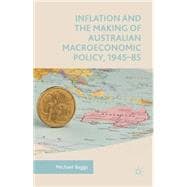The emergence of macroeconomics profoundly changed Australian economic policy after World War II. Though governments and the central bank pursued full employment, they soon found themselves contending with chronic inflation, and the instruments were often turned to restraint. This book explains how the problem of inflation transformed policy between the 1940s and the 1980s, well before the era of the independent inflation-targeting central bank. It explains how inflation came to undermine full employment, how governments dealt with international monetary chaos, and how the central bank pursued restraint within a rapidly evolving financial system.
This is a new interpretation of Australian policy history and the pre-history of 'neoliberalism'.
This is a new interpretation of Australian policy history and the pre-history of 'neoliberalism'.








